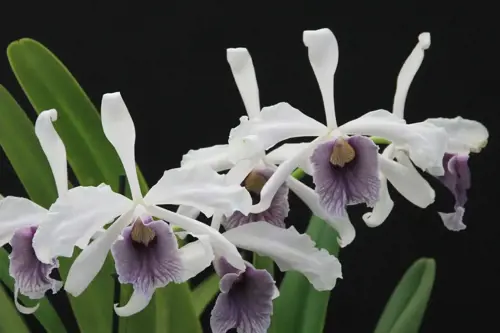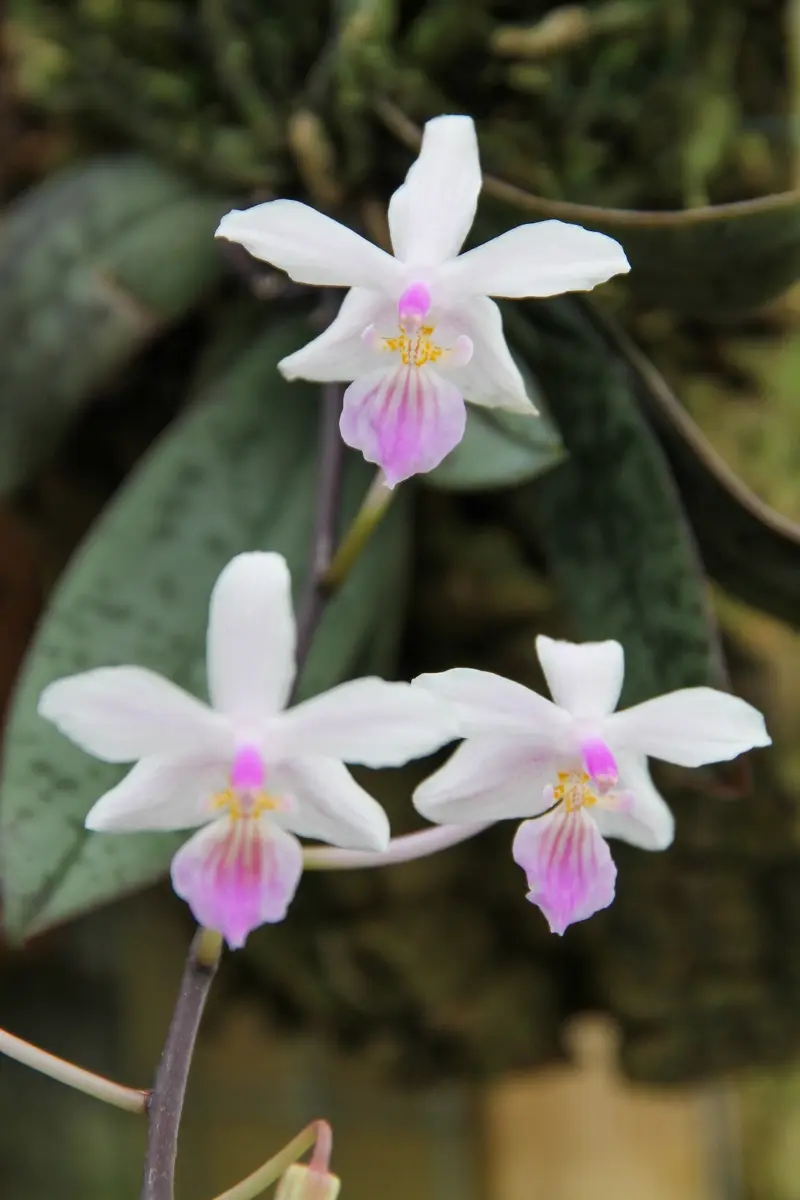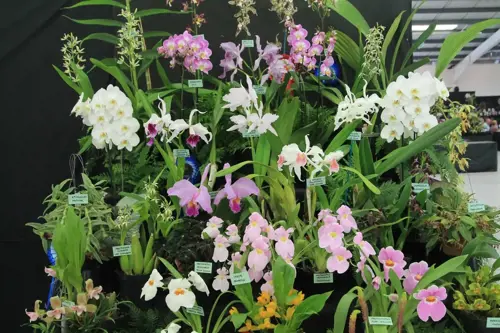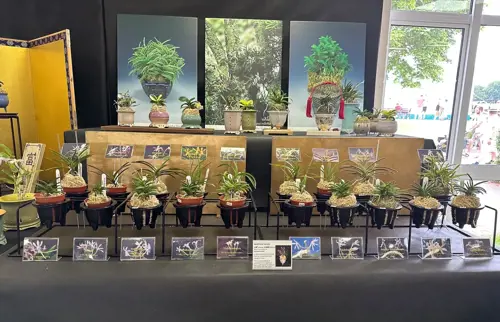24 May 2024
The Great Orchid Comeback
9 minutes
The UK’s largest orchid show moves to the BBC Gardeners’ World Live show at NEC Birmingham on June 13-16 to provide a bigger showcase for the UK’s most popular house plant
During Victorian times ‘orchid mania’ saw plants being auctioned for thousands of pounds as soon as they arrived at the London and Liverpool docks. Huge collections were amassed as their complexity, diversity and rarity fascinated scientists and obsessed the rich – but by the mid-20th century they fell out of fashion due to their high maintenance and the cost of heating large greenhouses.

|
Now, the orchid is back and once again it is the UK’s most popular flowering house plant. With the right care they will continue to produce flowers for many years and BBC Gardeners’ World Live plant expert Saul Walker says that once owners have got their plants to re-flower, they should look to collect a wider array of orchids. |
|
Saul, who is also vice chairman of Devon Orchid Society, said: “The moth orchid (Phalaenopsis) is the most common plant that you see in stores and supermarkets. It’s been successful because it is tolerant of the variable conditions in UK homes – but if you go to an orchid grower or an orchid show, you will see so many more that can all take different conditions and they look very different as well. “It's a bit like starting to cook with simple ingredients and suddenly you find there is a whole world of different cuisines open to you and it gets more fascinating. “The best to way to broaden your knowledge and collection is to go to orchid shows. This year, the UK International Orchid Show is moving to BBC Gardeners’ World Live at the NEC Birmingham on June 13-16 and will provide an important showcase of the variety of orchids you can grow at home. After all, there are 26,000 species and more than 200,000 registered hybrids – so why stick to one type?” Saul says his ‘gateway drug to orchids’ came through his grandparents who were keen orchid growers. He said: “They grew them on their windowsill – and when they would come to visit my family in Devon, they’d go to Burnham Nurseries in Newton Abbott. It is the largest orchid nursery in the UK that is privately owned. |

|

|
“They would take me along and I'd see all these fantastic plants that inspired me to grow them. I had a floor-to-ceiling window which I decked out in shelves and grew these fantastic plants. I slowly realised I could spend my lifetime in the world of plants as there’s so much to learn. It really fascinated me – and the natural world in general." “I studied a three-year Kew Diploma of Botanical Horticulture Kew Gardens and did a little stint within the orchid section – seven different climatically controlled greenhouses from the cool all the way to the really warm section of orchids. I got to travel to Australia, up into North Queensland, and go orchid hunting in the rainforest near Cairns." |
|
“At talks I always mention Phalaenopsis, the most common orchid now available and I describe how to look after them. I also talk about the Cymbidium, which has longer leaves and originates from places like the Himalayan foothills. They can go outdoors for about nine months of the year, so you can treat them like a pot plant that can go inside for winter." “Phalaenopsis would not appreciate being outside as they dry out far too quickly. I try to make sure people know the different genera all have different requirements, like any plant really, but it’s a little harder because people still think orchids are just one thing, whereas it's a very diverse group." “So orchid collecting is almost nerdy, it’s a plant that makes people excited, beyond others.” Critically endangered“Many orchids are now endangered including Epidendrum montserratense (endemic to Montserrat, Caribbean); Paphiopedilum druryi (endemic to South India and only found as small colonies in the Agastyamala Hills) and Phaius tankervilleae (linked to 18th century collections and the first tropical terrestrial orchids brought to flowering at Kew). “In fact, most of the genus Paphiopedilum is endangered, and the most exotic (therefore sought after and revered) examples are Paph. rothschildianum and Paph. sanderianum, both only found in a few, heavily guarded sites on Mount Kinabalu in Borneo. Fortunately, they are now widely cultivated. 600 species are on the International Union for Conservation of Nature (IUCN) Red List of Threatened Species. “A ghost orchid (Dendrophylax lindenii) featured in an exhibit at RHS Chelsea Flower Show last year to raise awareness of threated species. But the star attraction didn't open its flower bud until seven days after the show, after it was donated to Kew!” |

|

|

|
Raising awareness
Clive Lloyd is Show Secretary of the UK International Orchid Show, which will move from Malvern Three Counties Show to the NEC in June, and he says: “Keeping orchids in the public eye and raising awareness is important and there is a lot of good work going on in the UK to keep up the momentum.
“The orchid world is undoubtedly changing. You have to remember they are nearly always insect-pollinated and often only pollinated by one particular insect. So, with environmental damage, if you lose that insect, you lose the plant.
“A particularly good example of this is Vanilla, one of very few orchids which are economically important. It is native to Mexico and northern South America, where it is pollinated naturally, but the plants are also grown commercially in Africa, Madagascar and Indonesia and they must be hand-pollinated as they have no natural pollinators (one of the reasons why vanilla is so expensive).”
Rescuing collections
Clive says private collections sometimes need rescuing, too, otherwise the individual plants get sold on or, worse, plants are lost.
He said: “Thankfully, there is a charitable organisation called the Mathers Foundation in West Sussex which now holds several National Collections. Jill and David Mathers are keen orchid growers and saw collections being broken up as people were not able to look after them. They’re now rescuing these collections which so important.”

|

|
Clive has also been involved in helping to revive the orchid collection at the Botanic Gardens of Liverpool. The city was a place where orchids were once imported, and he is keen to keep the historic collection going.
He said: “I qualified as a vet at the University of Liverpool in the mid-1970s and in those days the Botanic Gardens had a huge orchid collection which inspired me to start growing them. The current collection is hidden and in a poor way, so the Liverpool Botanic Trust has been set up to bring the orchids back into the public eye.
“The Trust has got some Lottery funding and is looking to convert buildings to bring back a display. I'm helping them with sourcing plants.
“It all came about quite by chance. I retired three years ago, and I thought I'd love to go and see the orchids back in Liverpool. I then found out what had gone on. Although I'm an amateur orchid grower, I've been growing them for nearly 40 years and keen to help.
“I also wanted to raise awareness in the UK and when Saul Walker found himself trying to cover two shows – BBC Gardeners’ World Live and the International Orchid Show in Malvern on the same weekend I thought ‘why not move the international show to Gardeners’ World for a bigger showcase at the NEC?’.
“There will be a combination of orchid societies there, each with their own exhibits which will be in competition as well as specialist growers and nurseries – and lots of plants for sale. Visitors can get lots of advice.”

|
Top nurseries
|
Visit the show
UK International Orchid Show is at BBC Gardeners’ World Live
Birmingham NEC, June 13-16. Visit BBC Gardeners World Live | the NEC, Birmingham
Tops tips on growing orchids
- DO find out the requirements of your orchids – temperature, humidity, light, watering and feeding. You might find this online or contact/join a local orchid society.
- There are four main temperature ranges for orchids based on minimum winter night temperature:- hardy (0C); cool (10C); intermediate (13C) and warm (15 ). Do not try growing a plant in the wrong temperature zone – it will fail. Most centrally heated homes are around 15-20C at night.
- Most tropical orchids need at least 70% humidity, the average house has 30-50%, so do try improving humidity around your plants by frequent spraying/misting in the mornings, grouping plants together on gravel trays (use expanded clay granules). Do not put your orchids directly over radiators. Many orchids do well in bathrooms due to the extra humidity.
- Light requirements vary from quite deep shade to full sunshine, but as a general rule, do not put orchids in south-facing windows without some shade.
- More orchids are killed by overwatering than anything else. Do check your plants frequently by feeling the weight of the pot, the moisture in the compost and the colour of the roots if you have clear pots. Do not stand your orchids in water all the time. Water quality is also Do use rain, de-ionized, reverse osmosis or soft water but not hard water (if your kettle has limescale, the water is likely to be too hard for orchids).
- Do feed your orchids, but remember most are weak feeders. Use a fertiliser specifically designed for orchids, at no more than three out of four rounds of watering when the plants are growing.
Get involved
The Orchid Society of Great Britain holds its meetings in London but it is just one around 30 regional societies that make up the British Orchid Council (BOC).
BOC was founded to represent organisations nationwide with any interest or involvement in promoting orchid cultivation or conservation and apart from orchid societies, also includes the Royal Botanic Garden Kew, RHS, Glasgow Botanic Garden, the Eric Young Orchid Foundation, the Mathers Orchid Foundation and the Writhlington School Orchid Project. Find a society osgb.org.uk/affiliates
Meet Saul Walker
Saul will be giving tours of all the plants at Gardeners’ World Live throughout the show, hosting Houseplant Workshops and answering horticultural questions on the ‘Plant Experts’ Desk in the Floral Marquee.
Saul’s speciality interests include woodland gardens, orchids and exotic plants. A member of the RHS Tender Plant committee and trustee of The Hardy Plant Society, he also co-hosts the Talking Heads Podcast with Lucy Chamberlain.
He is Head Gardener of Stonelands House, a privately owned property with a 10-acre garden.
Insuring your garden
A garden is a sanctuary, yet it is safe to guess that not everyone considers the need for insurance.
Most insurers automatically provide a small amount of cover for plants, trees and shrubs within a home insurance policy, but check the levels of cover provided by your policy versus the overall cost and replacement of your plants.
Specialist items such as statues, sculptures and other garden antiques should be treated as fine art and not simply included under the general contents figure.
If you feel your garden may not be adequately covered under your household insurance policy, call 020 8256 4901 or email privateclients@howdeninsurance.co.uk
